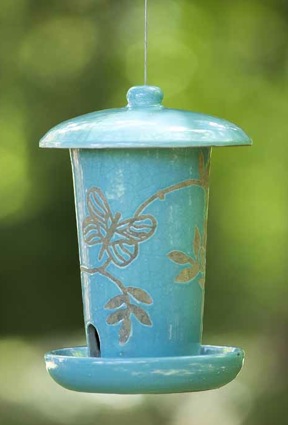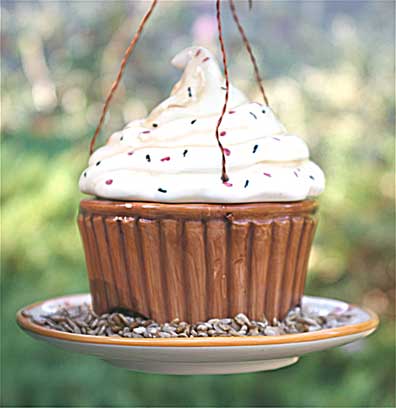-
It’s Not a Tray, not a hopper, nor a tube bird feeder
It’s deemed the “All Weather Feeder” and rightfully so!
An innovative design keeps seed dry- no matter what! Rain, snow and sleet can not penetrate this durable feeder because unlike a typical tube bird feeder, the seed ports are totally protected from the elements, even from driving, blowing rain.
Birds perch on a generous seed tray, and eat seed from above. The design consists of a built in weather guard, that overhangs and protects seed ports (and birds too). The All-Weather Feeder is available in a four or 6-quart capacity, and may be pole mounted or hung. There’s also an optional squirrel guard, or cage that fits around the open feeding area to keep pesky squirrels out! Stainless steel construction along with sturdy polycarbonate casing means this feeder won’t yellow with age either.
The optimal seed for this cool feeder is black oil sunflower, or a mix of safflower and black oil. Striped sunflower is actually too large for the seed ports. If you’re looking for a truly weather-proof bird feeder, this is it! By the way… it ships for free too 🙂
-
hopper bird feeders seem slow this time of year?
Backyard feeders may seem a bit slow this time of year… but it isn’t bye-bye birdie just yet! Although hummingbirds and other migratory friends have started their journeys to winter breeding grounds, many of your resident birds who brave harsh winters are still around.
Food in the wild is plentiful this fall, there’s an abundance resulting from the spring record rains (especially in the east). Fruit producing trees like Crabapples, and berry producing shrubs like Winterberry Holly, are heavily laden with fruit right now.
But you can be sure just as soon as it gets colder, they will return to your hopper bird feeders, suet feeders, and thistle feeders. Insects will disappear, and the berries and seeds of fall will be long-gone. Resident birds like Jays, Woodpeckers, Titmice, Nuthatches and even Bluebirds (in some areas) will over-winter. Keep bird feeders full and fresh… cuz they’ll be back soon!
-
un-square and un-boring hopper bird feeders
With so many variations of bird feeders out there, how would you ever pick the right kind if you’re new to backyard birding? Aside from offering fresh water in a bath, choosing several feeders which hold different kinds of food is very effective for enticing feathered friends.
There are five basic types of wild bird feeders, although variations abound! Hopper Bird Feeders like this ceramic blue one also add a decorative touch to any garden or landscape.
Tube Feeders dispense seed and allow multiple small birds to feed at once. The ones with very tiny ports are designed for thistle or nyjer seed-which is a favorite of Goldfinches and Pine Siskins.
Hopper Bird Feeders are likely the most popular type of feeder as they attract a wide variety of birds and generally have larger seed capacities. They feature removable or lifting lids for easy filling and cleaning, and a ledge, or perching space to accommodate several birds.
Platform or Fly-Thru Feeders will attract the widest variety of birds, they’re versatile for offering several kinds of treats that you can change with seasons. One drawback to this type of feeder is is that seeds can become contaminated with droppings and may mold quicker with the right weather conditions. A fly-thru feeder’s roof has an advantage to protect seed from weather.
Nectar Feeders are meant for Hummingbirds and Orioles, and may be seasonal according to your location.
We use them from mid-March through December in this North Georgia yard. Commercial nectar mixes are widely used, but we think the home-made sugar water solution is preferred.
Suet Feeders are usually a cage-type or bag feeder and should be protected from squirrels (and other pets). They’re great for offering fruit slices in summer, and nesting material in early spring. Many species covet suet for it’s high protein and fat content, especially during cold winter months. No-melt varieties of suet are also made for warm-weather feeding, as migratory birds also enjoy this special treat.
So that’s a basic run-down of wild bird feeders… although some may be more wild than others! This ceramic cupcake is also a variation of the popular hopper feeder.



